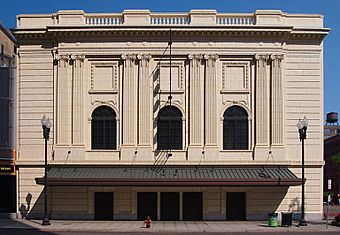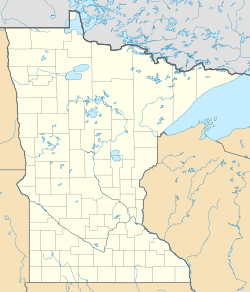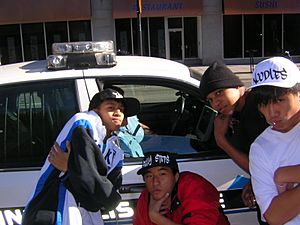Cowles Center for Dance and the Performing Arts facts for kids
Quick facts for kids Cowles Center for Dance and the Performing Arts |
|
|---|---|
|
Sam S. Shubert Theatre
|
|

The Goodale Theater of the Cowles Center for Dance and the Performing Arts
|
|
| Location | 528 Hennepin Avenue Minneapolis, Minnesota |
| Built | 1910 |
| Architect | Swasey, William Albert; Robinson, J.L. Co., et al. |
| Architectural style | Beaux Arts |
| NRHP reference No. | 95001230 |
| Added to NRHP | October 31, 1995 |
The Cowles Center for Dance and the Performing Arts is a special place for dance and other shows in downtown Minneapolis, Minnesota. It was once known as the Minnesota Shubert Performing Arts and Education Center.
The Cowles Center includes the Goodale Theater, which has 500 seats. It also has the Hennepin Center for the Arts, where many dance and performing arts groups are based. There is also a modern education studio and a connecting area called an atrium. The Cowles Center helped create, show, and teach dance in the Twin Cities area.
Sadly, the Cowles Center closed its Goodale Theater in March 2024. All its operations stopped in May 2024 because of money problems. This sudden closure meant the performance season ended two months early, and many planned shows were canceled.
Both the Goodale Theater and the Hennepin Center for the Arts are important historic buildings. They are listed on the National Register of Historic Places.
The Cowles Center also had a special program that started in 2002. It used video calls to connect artists with students in classrooms. This allowed students to learn from artists all over Minnesota, the country, and even the world. It was like having the artist right there in the room!
Contents
The First Shubert Theater
The Shubert Theatrical Company was started by three brothers: Levi, Samuel, and Jacob. They became very successful in the theater world in New York in the early 1900s. By 1920, they owned and produced more shows than any other group in America.
In 1905, Samuel Shubert died in a train accident. To remember him, his brothers named some of their new theaters after him. Two of these theaters opened on the same day in 1910. One was in Saint Paul, and the other was The Samuel S. Shubert Theater in Minneapolis. The Minneapolis theater later became The Cowles Center in September 2011.
Building Design and Opening Night
The Samuel S. Shubert Theater was designed by William Albert Swasey. It was a medium-sized theater for its time, with 1,500 seats. It had two balconies. The front of the building looked like a classical building. It had four pairs of columns and three arched windows. Many of the decorations on the outside were made of shiny terra cotta.
The very first show at the Minneapolis Shubert Theatre was The White Sister. A famous actress named Viola Allen starred in it. Tickets for the show cost between 50 cents and $2.50.
Early Years and Changes
Alexander G. “Buzz” Bainbridge became the manager of the Shubert in 1910. He was only 25 years old. The Shubert was built to host big Broadway shows that traveled around the country. But these shows stopped in the summer, leaving the theater empty.
So, the Shubert brothers asked Bainbridge to create his own acting group. This group, called the Bainbridge Players, became very popular all year round. Some of its actors, like Victory Jory and Gladys George, later became successful movie stars.
In 1915, the Shubert started showing movies. A large orchestra with 40 musicians played music along with the films. In 1918, a flu sickness caused all Minneapolis theaters to close. When the Shubert reopened, it had new lights and a bigger orchestra area. The theater was also repainted.
During the 1920s, movies became much more popular than live theater. The Shubert kept going until 1933, but it could not compete. Bainbridge closed his acting company. He then became the mayor of Minneapolis from 1933 to 1935.
The Alvin Theater
The Shubert theater reopened in 1935 with a new name: “The Alvin.” It was named after its new owner, William Alvin Steffes. Steffes added a cool, modern-looking sign to the front. The theater showed both movies and traveling Broadway shows.
In December 1940, the theater closed for two months. It then reopened as a theater that showed variety acts. Even after a fire in July 1941, which needed five months of repairs, The Alvin stayed open until 1953. Famous performers like Dudley Riggs, a comedian and juggler, performed there. He later started a famous comedy group called Brave New Workshop.
In November 1953, The Alvin changed again. A Reverend named Russell H. Olson turned the building into a church called the Minneapolis Evangelistic Auditorium. But the church closed just three years later.
The Academy Theater
The Shubert theater came back to life in 1957 when Ted Mann bought it. He turned it into a movie theater and called it The Academy. On July 12, 1957, The Academy hosted the first showing in Minneapolis of the movie Around the World in Eighty Days. The movie's producer, Michael Todd, used to sell candy at the old Shubert Theater. He came to the opening with his wife, Elizabeth Taylor, who was a very famous actress.
The Academy started to have problems as new movie theaters with many screens opened in the suburbs. These new theaters made it hard for single-screen theaters like The Academy to succeed. In 1983, the theater closed its doors once more.
Saving the Shubert Theater
In 1987, the area where the Shubert was located had a lot of crime. The city of Minneapolis decided to rebuild the area. But this plan meant the Shubert theater might be torn down.
Most of the buildings in the area were torn down in 1988 and 1989, but the Shubert remained. In 1990, a group called the Heritage Preservation Commission convinced city leaders not to destroy the Shubert. A group called Save Our Shubert wrote letters and held peaceful gatherings outside the theater. In 1996, the Shubert was added to the National Register of Historic Places. This meant it was protected as an important historic site.
Moving a Giant Building
A clever idea came from Tom Nordyke, who worked for Artspace. He suggested moving the Shubert theater out of the way. This idea would help save the building, allow new development, and support the arts. Engineers studied the idea and found that moving a 6-million-pound building a few blocks was actually possible!
It took twelve days to move the theater in February 1999. It traveled from its old spot to its new home on Hennepin Avenue. At 5.8 million pounds, it was the heaviest building ever moved on rubber tires. This amazing feat even earned a Guinness World Record!
The Shubert was too big to move on regular city streets. But luckily, only parking lots were between it and its new location. After the move, the building was renovated and became The Cowles Center for the Performing Arts.
Goodale Theater Features
The Goodale Theater was completely updated and now has 505 seats. No seat is further than 65 feet from the stage, so everyone gets a great view. The rows of seats curve around to face the center of the stage.
Beautiful cherrywood columns and old architectural details frame the stage opening. The floors backstage are covered with a special material. This allows ballet dancers to walk from their dressing rooms to the stage without taking off their special toe shoes. The large backstage areas and dressing rooms give performers plenty of space.
The orchestra pit can hold up to 42 musicians, allowing for live music during shows. This pit can also be changed to add two more rows of seats for the audience. The stage is very big, giving dancers lots of room to perform large shows. It also has a tall stage house with 52 rigging lines. These lines can hold up many different and fancy set designs.
U.S. Bank Atrium
The main entrance to The Cowles Center is called the U.S. Bank Atrium. Here, you can find the ticket office, an information desk, and a place to buy snacks. This area also has a wall honoring people who have donated money to the center. From the atrium, you can enter the Goodale Theater and The Hennepin Center for the Arts.
Above the snack area, there is a special art piece inspired by a dance called Rites of Spring. This art uses Labanotation. Labanotation is a way of writing down dance movements, just like music notes write down music. It uses symbols to show where a dancer's body parts are, which way they are moving, how fast, and how strong their movements are.
Target Education Studio
The Target Education Studio was designed just for dance. It has a special maple wood floor that is bouncy, studio lights, and a wall of mirrors. This studio is where the center's long-distance learning program takes place.
Using video call technology, the center connects artists with classrooms. This creates live, two-way teaching sessions. Thanks to generous donations, the center can even offer free sessions to schools in Minnesota.
First Season of Shows
The Cowles Center's first season of shows ran from the fall of 2011 to the spring of 2012. It brought many different dance companies from Minnesota to perform in one place. Some of the dance companies that performed during this first season included:
- Ragamala Dance
- Minnesota Dance Theatre
- Beyond Ballroom Dance Company
- Black Label Movement
- Zorongo Flamenco
- Native Pride Dancers
- James Sewell Ballet
- Matthew Janczewski's Arena Dance
- Stuart Pimsler Dance and Theater
- Katha Dance Theater
- Shapiro and Smith Dance Company
- Zenon Dance Company
- Breaking Boundaries Dance Company
- Tu Dance
The first season also featured a vocal group called Cantus. A dance group from New York called Kegwin + Company also performed.
|




